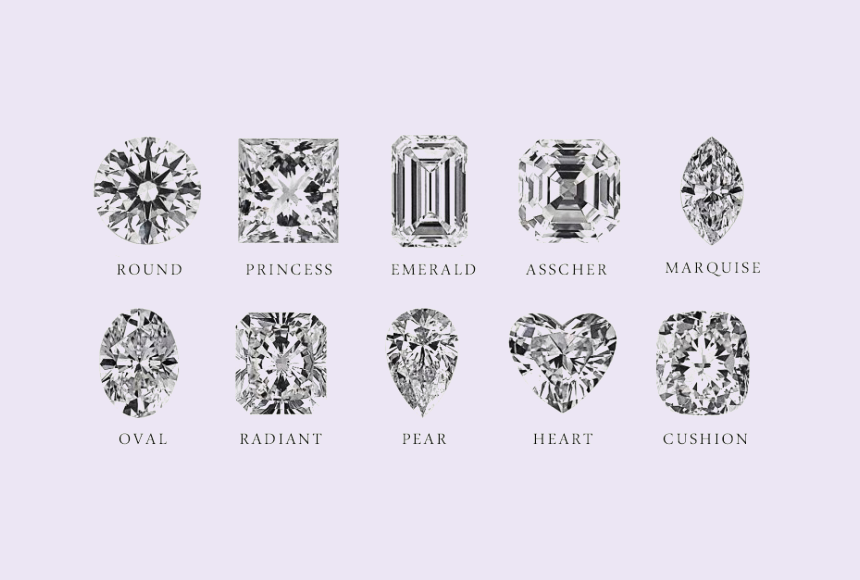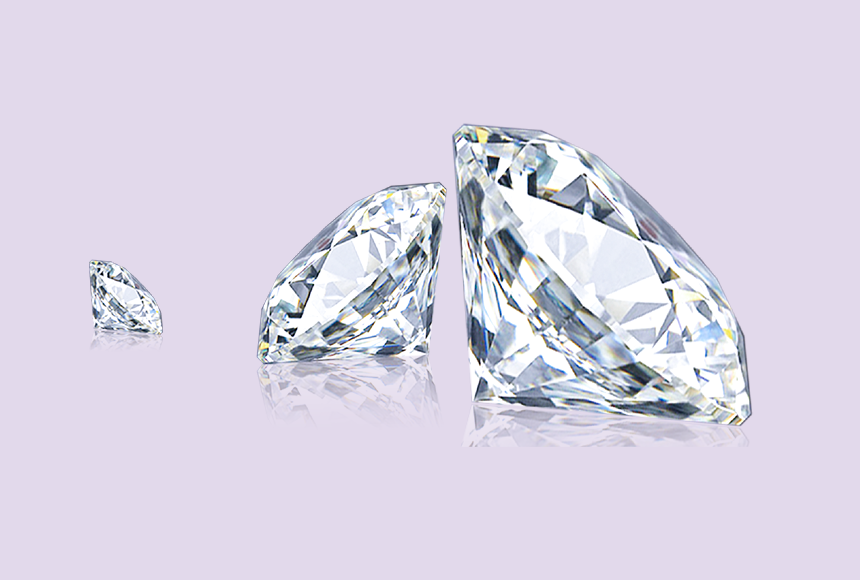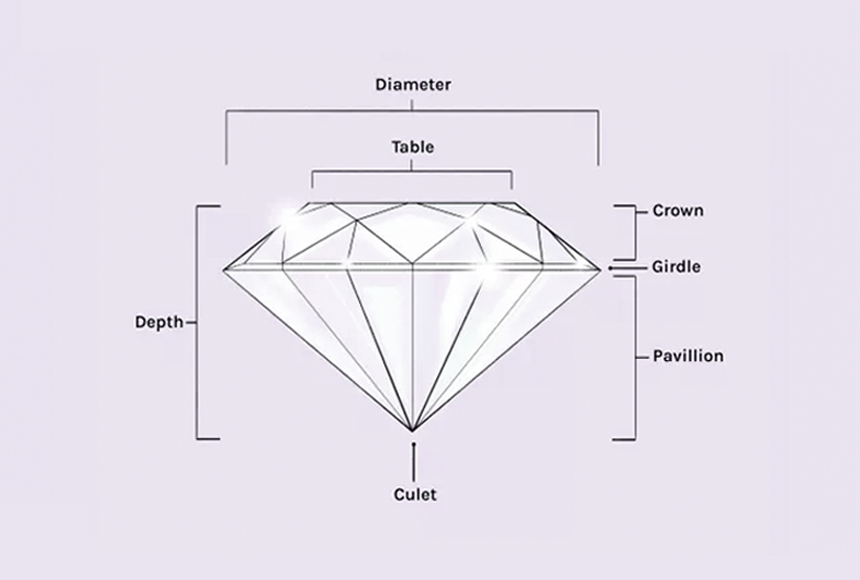Fast Search
- Love Check
- Marquise diamond
- Bypass ring
- Heart ring
- Classic eternal style
- Wedding season
- Trendy style
- Men's ring
- International designers collection

Fast Search
- Love Check
- Marquise diamond
- Bypass ring
- Heart ring
- Classic eternal style
- Wedding season
- Trendy style
- Men's ring
- International designers collection

4Cs of Diamonds
Oct 12,2023
Today, the value of a diamond has taken on a whole new dimension and meaning. They are significantly tied to eternal love, marriage, and durability. To assess and grade the value of diamonds, the Gemological Institute of America (GIA) created the 4Cs of diamonds, namely cut, color, clarity and carat, which are international general indicators of the quality of any diamond.
A detailed understanding of the 4Cs of diamonds will help you get a beautiful diamond engagement ring that offers great value for your money. From the diamond 4Cs to diamond certification - here is your complete guide to choosing the best diamond for your ring.
Darry Ring insists on rigorous diamond grading guidelines and goes beyond the basic “diamond 4Cs”. Additionally, we have also set out strict specifications and considerations of DR diamonds to create a token of true love for each couple.
CUT
1. What is a Diamond Cut?
Diamond cut refers to the proportional balance of table percentage, depth percentage, symmetry obtained after a rough diamond has been cut and polished. It is an indicator used to assess the brilliance, fire and sparkle of a diamond.
The diamond cut largely determines the diamond shape, so a large number of people mistakenly equate the diamond cut with the diamond shape. However, diamond cut is essentially about the effect of the diamond's facets interacting with the light.
2. How Does the Diamond Cut Affect the Brilliance, Fire and Scintillation of a Diamond?
Let’s take a look at the definition of the brilliance, fire and sparkle before answering this question.
● Brilliance refers to the internal and external white light reflected by the diamond.
● Fire refers to the scattering of white light into all the colors of the rainbow. You are more likely to see flashes of the rainbow colors in strong light environments.
● Scintillation refers to the amount of sparkle produced by the diamond and the pattern of light and dark areas caused by the light reflection inside the diamond.
A gemstone requires precision and craftsmanship. Only a diamond with perfect table proportions, depth proportions, symmetry and polish after cutting will maximize the effect of light reflection and create a stunning visual effect.
To know whether a diamond has the perfect table percentage, depth percentage, symmetry and polish, it is necessary to figure out the anatomy of a diamond. Usually, a diamond is composed of table, crown, girdle, pavilion and culet.
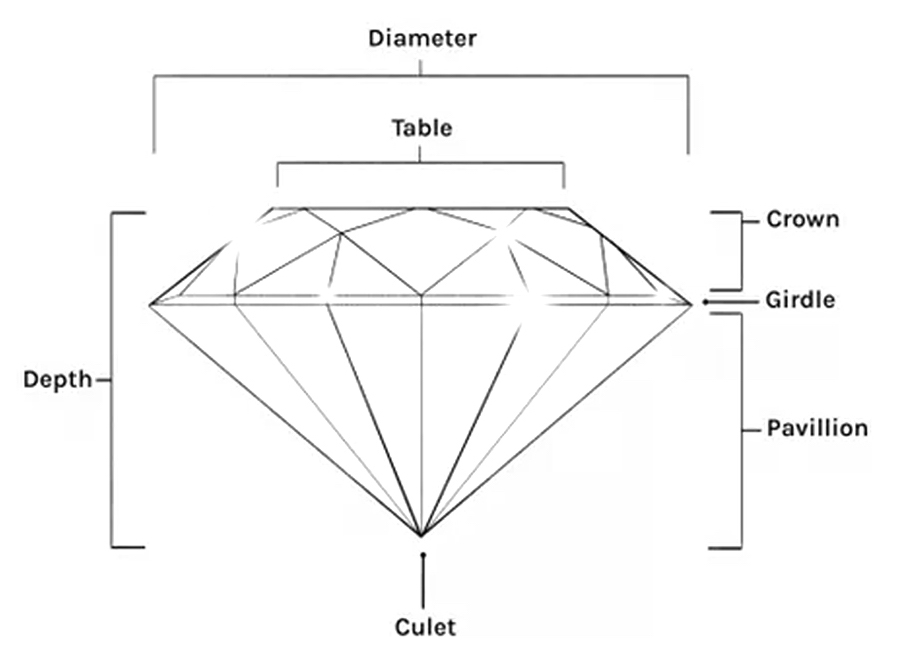
● Diamond Table refers to the largest facet of the diamond, mostly the flat surface at the top.
● Diamond Crown is the portion of the diamond from the table to the girdle (i.e. the widest part of the diamond).
● Diamond Girdle is the intersection between the diamond crown and the diamond pavilion, the widest part of the diamond. Therefore, the size of the diamond girdle represents the circumference of the diamond.
● Diamond Pavilion is located between the girdle and the culet. It is an integral part of the diamond's reflective properties.
● Diamond Culet is the smallest facet (it is a point) and is located at the very bottom of the diamond.
With a basic knowledge of diamond anatomy, it is easy to know what the table percentage, depth percentage, symmetry, and polish are.
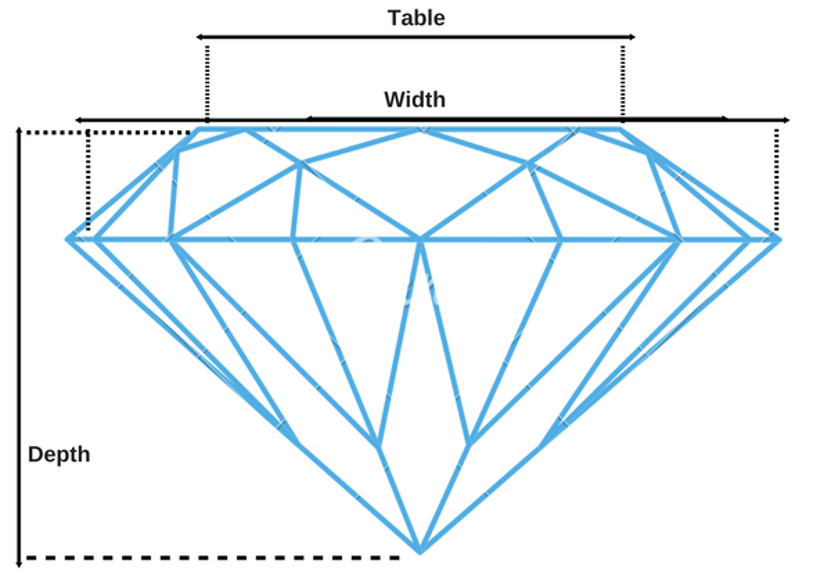
● Table Percentage is the ratio of the width of the top facets to the maximum width of the diamond.
● Depth Percentage is the ratio of the millimeter height from the diamond table to the diamond culet to the maximum width of the diamond.
● Symmetry means that the facets surrounding the diamond, both in two dimensions and in three dimensions should be proportionally symmetrical.
● Polish means that each facet of the diamond should be polished after the cutting process.
The table ratio and depth ratio of a diamond is one of the most important dimensions in determining the brilliance and the ability of a diamond to reflect light. The perfect diamond table percentage and depth percentage allows light to enter the diamond from the table, to reflect through the pavilion, then to exit the table, resulting in an abundance of fire and brilliance.
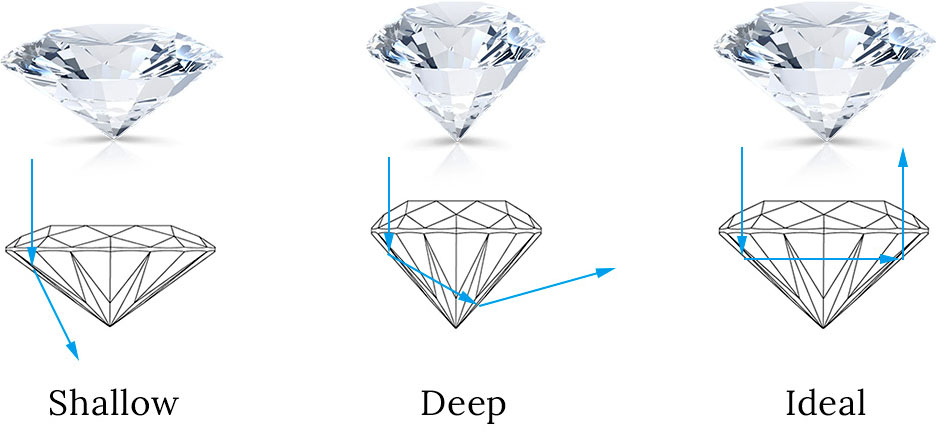
If the table percentage is too large or the depth percentage is too low, light will escape from the diamond table without strong light reflections. If the table percentage is too low or the depth percentage is too large, the light will be trapped inside the diamond or go out from the bottom without producing fire and sparkle.
3. Ideal Diamond Table Percentage and Depth Percentage Table
Because depth ratio and table ratio play such an important role in determining the appearance, brilliance, fire and value of a diamond, they are two of the most important factors to keep in mind when you are buying a diamond engagement ring. Different diamond cuts have different requirements for the ideal diamond table percentage and depth percentage, so check out the table below.
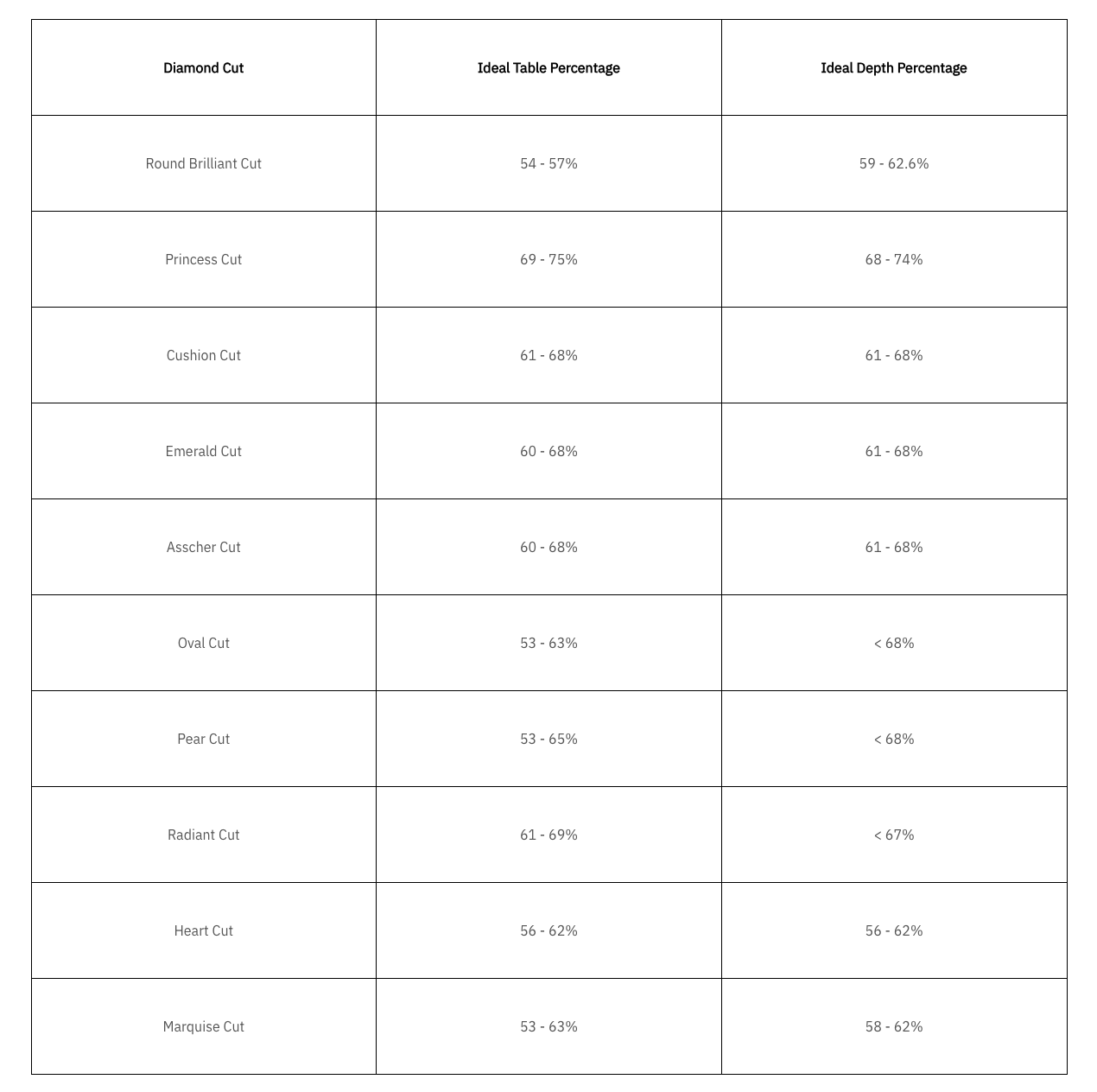
4. Diamond Cut Grade Chart
Of all the 4Cs of diamonds, the diamond cut is the most complex and technically difficult to analyze. The international grading system developed by the GIA divides diamond cut into five grades, from excellent to poor.
● Excellent: When light enters the diamond with an excellent cut, diamonds in this grade have high sparkle, high brilliance, and an even pattern of dark and light areas.
● Very Good: When light enters the diamond with a very good cut, diamonds in this grade have darker color at the edges or center, despite high sparkle and brilliance.
● Good: Diamonds in this category are less sparkly and darker when light enters.
● Fair: Diamonds in fair cut have a slight sparkle and brilliance when light enters.
● Poor: Diamonds in this grade are dull and have little or no sparkle and brilliance when light enters.
Darry Ring refuses to compromise on poorly cut diamonds and does not sell diamonds with “fair” and “poor” grade, as they do not match our pursuit of high quality DR diamonds.
COLOR
1. What is the Diamond Color?
Diamond color is an indicator used to determine the subtle differences in color of a white diamond from colorless to yellow. The Gemological Institute of America classifies diamonds by color starting from D (colorless) to Z (yellowish). The closer a diamond color is to colorless (D grade) indicates the rarer the diamond (except for colored diamonds) and therefore the higher the value.
In white diamonds, yellow tones are not usually considered desirable, due to the fact that the diamond reflects back less light when a slight color is present.
2. Why Does the Diamond Color Grading System Start with D?
This is because before the GIA introduced the D to Z diamond color grading scale, various grading systems existed, ranging from the undefined A, B, C to Arabic numerals (0, 1, 2, 3) and Roman numerals (I, II, III), and so on. In order not to be associated with the earlier grading systems, the GIA created diamond color grades starting with the letter D.
3. Diamond Color Grade Chart
Darry Ring classifies diamond color into five grades, from colorless to light yellow, according to industry standards. This is measured by comparing a diamond under controlled lighting and precise viewing conditions to a colorimetric stone with a given color value.

● Colorless contains diamonds with color grades D - F. Colorless diamonds are the rarest on the market today and are usually set in platinum and white gold ring, making them the most valuable.
● Near Colorless contain diamonds with color grades G - J. The difference in color between these diamonds is so subtle that it is almost impossible for a layman to distinguish between them. Near-colorless diamonds do not exhibit significant color in most cases.
● Faint contains diamonds with color grades K - M. Starting from the color grade K, these diamonds can be seen by the naked eye to exhibit a faint yellow color. Due to the warm yellow hue of the metal, the faint yellow diamond can also be beautiful and delicate when paired with a yellow gold ring, which would be an affordable option.
● Very Light contains diamonds with color grades N - R. These diamonds are already fully visible to the naked eye with a very light yellow tint.
● Light contains diamonds with color grades S - Z. These diamonds can be clearly seen with the naked eye as having a yellow or brown color.
Again, Darry Ring refuses to compromise on diamonds with poor color grades and does not sell diamonds with color grades K - Z, as they do not meet our standard for the highest quality DR diamonds.
4. What is the Best Diamond Color Grade?
The most popular diamond color grade at Darry Ring is H, followed by G and F.
If you are looking for the highest quality diamonds, we recommend that you choose a diamond with color grade D, E or F. These diamonds are very rare and the quality is most assured.
However, if you wish to spread your budget and balance the quality of your diamond between other elements, then diamonds in the G - J color grades are a good choice, which are the most popular diamond color grades today. These grades have subtle color differences from colorless diamonds that are difficult for the layman to recognize.
If you have a passion for gold jewelry and are on a budget, you may want to consider a K - M grade diamond. Not only do these diamonds work well with the gold brand, they are also an affordable option.
CLARITY
1. What is the Diamond Clarity?
During the formation of a natural diamond there are irregularities in the atomic structure caused by the tremendous heat and pressure deep in the earth, resulting in diamonds with inclusions or flaws.
Diamond clarity is an indicator of whether a diamond contains inclusions on the inside and flaws on the outside. It is used to determine the purity of a diamond.
2. How Important is the Diamond Clarity?
The diamond clarity can have a significant impact on the value of a diamond. Diamonds with inclusions have a direct impact on brilliance as the inclusions prevent the refraction and return of light. Conversely, the fewer inclusions and flaws a diamond has, the higher its clarity and, accordingly, the higher its price.
3. Diamond Clarity Grade Chart
Diamond experts from organizations such as the Gemological Institute of America (GIA) and the American Gem Society (AGS) use a microscope with 10x or even greater magnification to identify any inclusions and flaws that may be present. Diamond experts assign a given scale of diamond clarity grades to each diamond within a standard range.
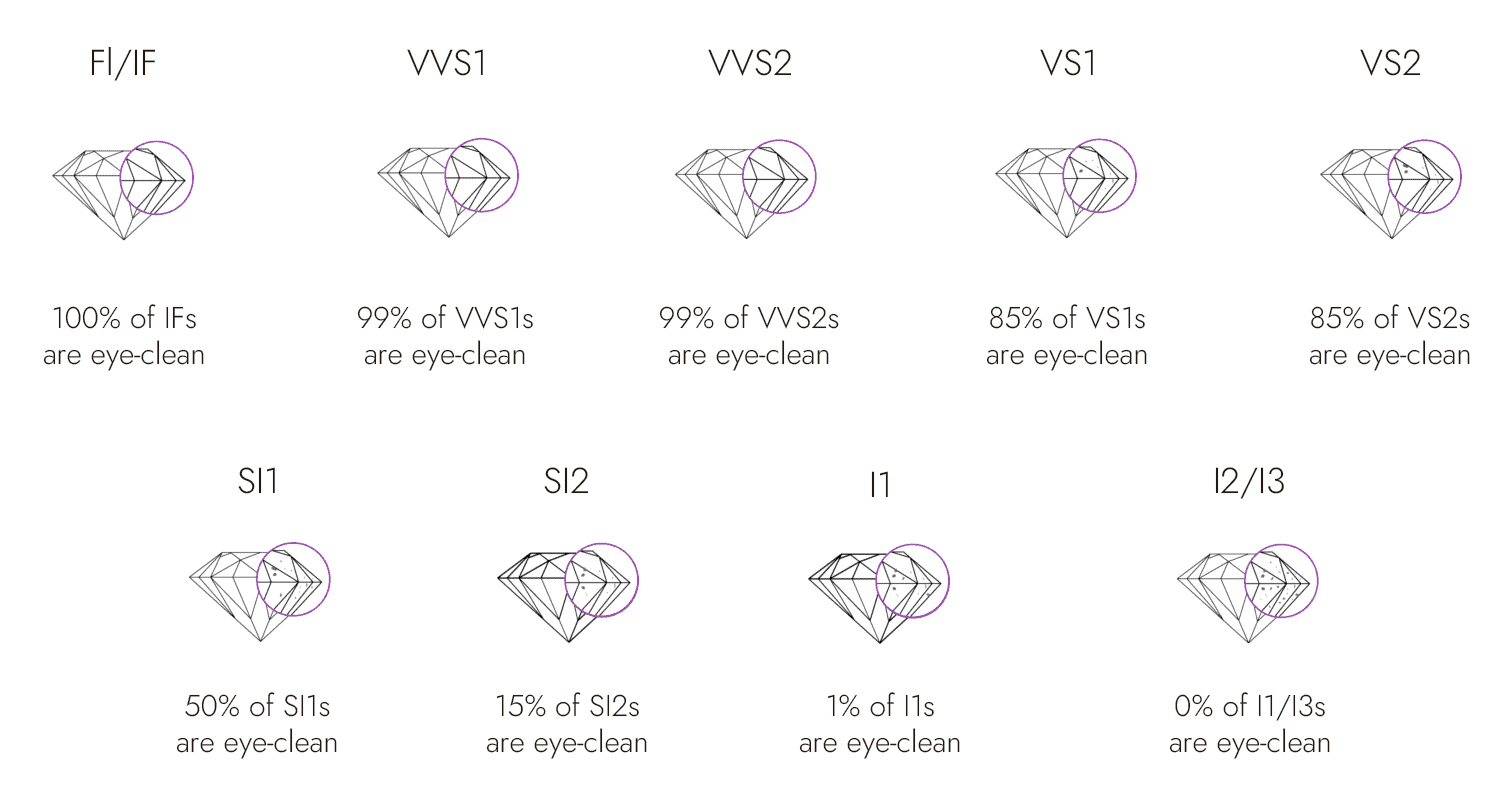
Thus, the clarity scale for diamonds is divided into six categories with 11 grades, from Flawless to Included, and they are:
● Flawless contains diamond clarity grades FL (flawless) and IF (Internally Flawless). It means that the diamond is free of inclusions and flaws when viewed under 10x magnification. Flawless diamonds are the rarest diamonds.
● Very, Very Slightly Included contains diamond clarity grades VVS1 and VVS2. The inclusions in these diamonds are so slight when viewed under 10x magnification that they are difficult to see, even for a skilled grader.
● Very Slightly Included contains diamond clarity grades VS1 and VS2. The inclusions can be seen inside these diamonds when viewed diligently under 10x magnification.
● Slightly Included contains diamond clarity grades SI1 and SI2. The inclusions can be seen inside the diamond under 10x magnification. For emeralds and Asscher cut diamonds with grade SI2, inclusions are likely to be visible to the naked eye.
● Included contains diamond clarity grades I1, I2 and I3. The inclusions are obvious and clearly visible under 10x magnification. Most brilliant cut diamonds with clarity grades I2 and I3 have inclusions visible to the naked eye, which may have a significant impact on the fire and brilliance of the diamond.
Similarly, Darry Ring refuses to compromise on diamonds with poor clarity grades and does not sell diamonds with clarity grades from I1 to I3, as they do not meet our standard for the highest quality DR diamonds.
4. What is the Best Diamond Clarity Grade?
There is no doubt that the best diamond clarity grade is FL, which are the rarest and most expensive. But less than 1% of diamonds are rated as flawless and 99% are imperfect.
You may have a hard time choosing all the best grade among diamond 4Cs because of their rarity and expensive price, but you can choose the two factors you are most concerned about to balance with the other two elements.
Therefore, if you have more budget to spend on the clarity of your diamond, we recommend that you choose a clarity grade of VVS2 or higher, which refracts the maximum amount of light for dazzling fire and sparkle. Instead, we recommend that you choose a clarity grade of SI1 and above, where the inclusions are invisible to the naked eye and do not affect the effect of fire and brilliance.
CARAT
1. What is a Diamond Carat?
Diamond carat refers to the unit of measuring the weight of a diamond, not the size and dimensions. According to the GIA, one carat in the metric system is equivalent to 200 milligrams or 0.2 grams. Each carat can be subdivided into 100 “points”, which is used by many jewelry businesses to describe the weight of a diamond under one carat. For example, a 0.25 carat diamond can be described as 25 points.
Obviously, the diamond carat does not tell you definitively the size or weight of a diamond, so how did the diamond carat system begin.
In fact, the diamond carat is derived from the Greek word for “seed of the carob tree”. Because the seeds of the carob tree are almost always the same size, early gem dealers used the them as a measure of weight. It was not until the Fourth Congress of Weights and Measures in 1907 that it was agreed that the modern carat of diamond should equal 200 milligrams. Thus, diamond carat become the standard unit of measurement used today to measure the weight of diamonds.
2. Diamond Carat Chart
When people are looking at your diamond ring, most of their eyes are drawn to the diamond set in the ring. Although carat is not a unit of measurement for diamond size, as the carat weight of a diamond gets larger, the physical size of the diamond gets larger. As an example of a round cut diamond, view the sizes of diamonds of different carat weights in the table below.
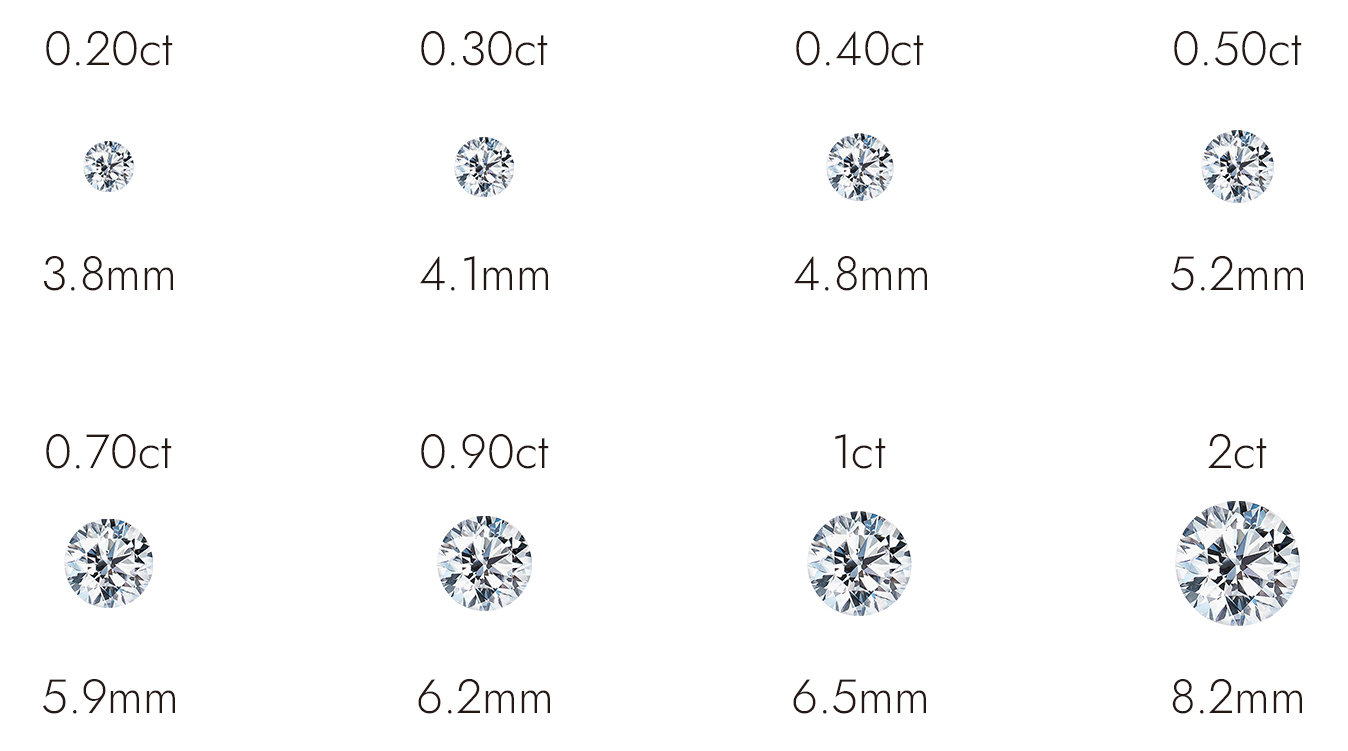
3. How Big is a One Carat Diamond?
The size of a 1 carat diamond has a lot to do with the depth and shape of the diamond cut. If you compare 1 carat round diamond engagement rings with different depths of cut, you will notice that a deeper cut round brilliant diamond will look smaller than a shallower cut round diamond.
Different diamond cuts can also give a different impression for the same carat weight. For example, a 1 carat round brilliant diamond is approximately 6.5 mm in diameter, while a 1 carat square brilliant diamond is approximately 5.61 mm in diameter. When viewed from the front, a 1 carat round diamond engagement ring is much larger than a square diamond engagement ring. View sizes for different diamond shapes with the same 1 carat weight in the table below.
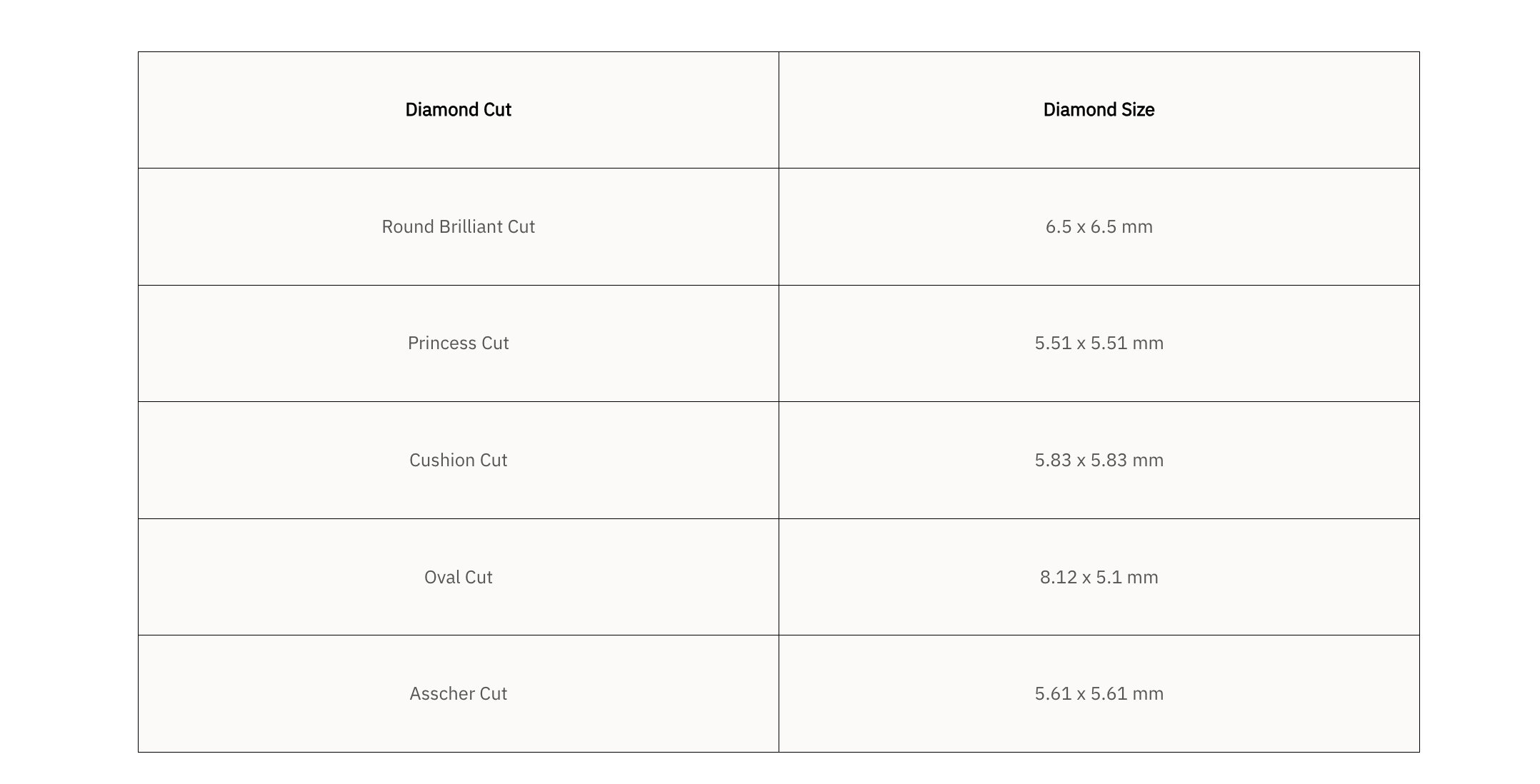
4. What is the Best Diamond Carat?
1 - 2 carat diamond engagement rings have become the most popular choice of diamond weight in modern times. If you don't have the budget for a diamond over 1 carat, why not consider a 0.75 carat diamond, which is the best value for money without making the diamond look small.
Darry Ring carefully selects each diamond according to the 4Cs of diamonds, to ensure that every diamond is brilliant and sparkling. When you purchase a DR diamond engagement ring, you will receive a ring certificate including the 4Cs of the diamond you are buying, from an authority such as the GIA or AGS. DR Rings are a stunning masterpieces of mastery and nature, glowing with unique brilliance.

